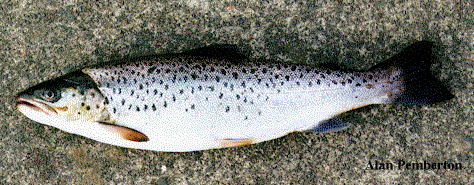Identification:
The sea trout is a migratory form of the familiar brown trout.
This is a muscular, rounded fish, with silvery colour and a variable amount
of dark blotches on the upper body, which can extend below the lateral line.
In general, the sea trout is stouter than the salmon, and broader at the
neck of the tail (it is said that when held by the tail, a sea trout will
slip through the fingers, while a salmon will hold steady). The "fatty" adipose
fin, characteristic of salmonids, is present between the dorsal and caudal
fins, and the relatively indistinct lateral line is straight.
The breeding male is darker, with increased spottedness and a distinct upward
curvature to the lower law.
Breeding:
Sea trout migrate from the sea into rivers to spawn between July
and November; females laying about 10,000 eggs. Breeding mortality is not
high, and after spawning, sea trout return to the sea. The young develop
in fresh water, feeding principally on insects until reaching a length of
15-25 cm, when they migrate to the sea. After spending 0.5-5 years in salt
water, the sea trout begins yearly breeding migrations back into fresh water.
Habitat:
While at sea, sea trout tend to remain close to the coast, particularly favouring
estuaries, or other areas where fresh water enters the sea.
Food:
Small fish and crustaceans form the mainstay of the marine diet of the sea
trout.
Range:
Found all round UK coasts.
Additional Notes:
Sea trout are farmed commercially in the UK. Wild sea trout are regarded
by many as the ultimate prize in both angling and culinary terms. |

